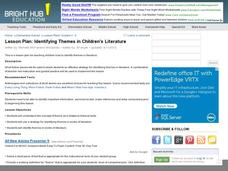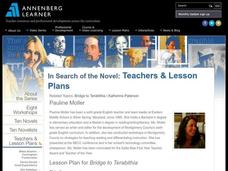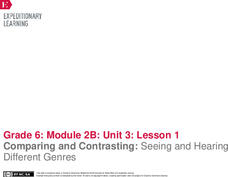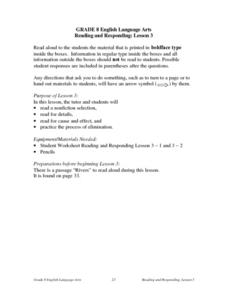Achieve3000
Listening for Main Idea and Supporting Details
Did you hear that? It's the main idea! Teach your class listening and note-taking strategies for determining the main idea by following the steps provided in this plan.
Curated OER
Identifying Themes in Children's Literature
Identifying themes in literature is the focus of the language arts lesson plan presented here. Learners read short pieces of fiction and practice the skill of identifying the themes present in each one. The bulk of the lesson consists of...
Curated OER
Bridge to Terabithia
Students explore scenes from Katherine Paterson's book, Bridge to Terabithia. For this visualization lesson, students listen to the story read aloud. The students then choose words and phrases that paint a picture in their heads....
Santiago Canyon College
Taking Notes for Science Class
Provide young scholars with the tools they need to succeed with this reference on the Cornell note-taking strategy. By breaking the content of lessons into main ideas, supporting details, and overall summaries, students are able to...
Curated OER
Webbing Context Clues
Fifth graders explore strategies for identifying the meaning of unfamiliar words. For this vocabulary lesson, 5th graders apply a think aloud strategy for unfamiliar words. Students use context clues to identify unfamiliar words and...
Scholastic
A House for Hermit Crab
Engage young marine biologists in a reading of Eric Carle's A House for Hermit Crab with a fun hands-on activity. Given a set of clipart images of the different aquatic animals that appear in the book, children identify each one during a...
Curated OER
Journey to Topaz: Directed Reading Thinking Activity
Have you used the directed reading thinking activity in your classroom? Doubling as either a prereading strategy, or a during reading strategy, it helps readers connect the historical background of the text to the text itself. As the...
Curated OER
Literacy in Content Areas: Think Aloud
Fifth graders examine the "think aloud" reading strategy. In this reading strategies instructional activity, 5th graders apply the think aloud strategy to solving word problems in math.
Novelinks
The Cure: Vocabulary Bingo
As part of their study of the vocabulary used in Sonia Levitin's The Cure, class members create a card, filling in words from the novel, and then engage in a bingo game.
EngageNY
Author’s Read: Final Performance Task
Scholars submit their final performance task, a letter to a publisher about an athlete's legacy. As a culminating activity, they share their work with classmates in small groups.
EngageNY
Advanced Factoring Strategies for Quadratic Expressions (part 1)
Factoring doesn't have to be intimidating. Build on prior knowledge of multiplying binomials and factoring simple trinomials to teach advanced factoring of quadratic expressions with a activity that uses various methods of exploring the...
Houghton Mifflin Harcourt
One Land, Many Trails: English Language Development Lessons (Theme 5)
English is not the only subject that requires its own set of vocabulary words—geography does too! A series of language development lessons designed to be used with Theme 5: One Land, Many Trails helps introduce readers to key vocabulary...
Curated OER
Introduce Vocabulary: Make Way for Ducklings (McCloskey)
Use the Caldecott Award-winning book Make Way for Ducklings by Robert McCloskey (which can be found on YouTube if you don't have it) to guide budding readers through vocabulary in context. Although the instruction here is limited to the...
Curated OER
Theater: Create a Script
Figurative language is the focus in the book Teach Us, Amelia Bedelia. After reading Peggy Parish's book, class members dramatize idioms from the text, using dramatic strategies such as characterization, exaggeration, and improvisation....
University of North Carolina
Commas
Every time you pause while reading, you should insert a comma, right? Not necessarily. Using a comma to indicate a pause is just one of the myths addressed in a handout related to the pesky punctuation mark. After reviewing common...
EngageNY
Comparing and Contrasting: Seeing and Hearing Different Genres
Let's compare and contrast! Scholars use a Venn diagram to compare and contrast the experience of reading a poem and listening to its audio version. Next, they complete graphic organizers, comparing two different genres: a poem and a...
Curated OER
Discovering Rhythm and Rhyme
Students explore ways to provide enjoyable phonemic awareness and conversation experiences for their children while reading and discussing children's book, A Tree For Me. Students extend their expertise in reading by fluently reading...
Curated OER
Getting to Know You
After going over the five steps of the writing process, pupils fill out "Getting to Know You" worksheets. They trade papers with each other, and have the task of writing a descriptive paragraph about the person whose worksheet they...
Curated OER
Lesson Plans That Boost Reading Comprehension
Reading comprehension is a cyclical process that can be supported with lesson plans that build students' knowledge and cognition.
Curated OER
Rain
First graders practice oral and silent reading using beginning comprehension and decoding strategies. In this guided reading lesson, 1st graders take a picture walk and make plot predictions prior to reading the book Rain by Robert...
Curated OER
Reading Comprehension Strategy Ideas
Young scholars participate in pre-reading activities, journal keeping, vocabulary lists and other reading comprehension boosters. These activities can be applied to many genres.
Curated OER
Reading for Tone and Inference
Using a reading passage, this lesson leads learners through an exploration of a text. This activity focuses on identifying what the reading passage is about, its tone, and key elements.
Curated OER
Reading and Responding: Lesson 9
Eighth graders listen to a read aloud of Robert Frost's poem "The Road Not Taken." They examine the attributes of poetry focusing on stanzas, imagery, and punctuation. They participate in choral readings before completing the associated...
Curated OER
Reading and Responding: Lesson 3
Eighth graders practice reading a nonfiction selection. They read for details, read for cause and effect, and practice the process of elimination. They use these strategies when answering multiple choice questions in tests.

























